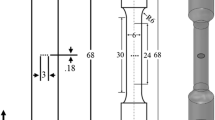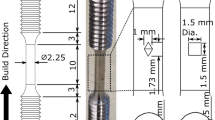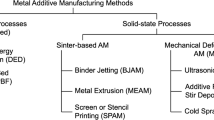Abstract
Background
Porosity and other defects resultant by additive manufacturing processes are well-known to affect mechanical properties. However, there remains limited understanding regarding how the internal defect structure influences the evolution of the local strain field, as experimental investigations have not presented direct measurements of the evolving internal strain field in the presence of defects.
Objective
Interrupted in-situ tensile tests in a lab-based X-ray computed tomography machine were used to investigate the evolution of the strain field around internal defects. The evolution of the internal strain field facilitated examination of the role of specific defects in the macroscopic deformation of additively manufactured tensile coupons.
Methods
Samples were produced in 316L stainless steel by laser powder bed fusion. An in situ loading device was utilized to subject the samples to tensile failure within a tomographic scanning environment. Digital volume correlation was utilized to directly determine local strain levels within the additively manufactured components in the vicinity of porosity defects.
Results
Effects of porosity on strain localization and eventual failure of the samples were evaluated. Characteristics of the porosity distribution, including presence of porosity at the surface or near-surface of components, as well as the proximity of pores to each other were found to influence the evolution of failure. Early onset of failure was found to be associated with the availability of neighboring porosity that allowed for rapid progression of the fracture path.
Conclusions
The direct measurements of strain field evolution in the present study established understanding regarding how internal defect structure characteristics influence the evolution of the local strain field for additively manufactured components. This high fidelity characterization and the associated phenomenological observations have bearing for supporting validation of numerical modeling frameworks for describing failure in these materials.














Similar content being viewed by others
References
Becker R (1987) The Effect of Porosity Distribution on Ductile Failure. J Mech Phys Solids 35(5):577–599
Mower TM, Long MJ (2016) Mechanical Behavior of Additive Manufactured, Powder-Bed Laser-Fused Materials. Mater Sci Eng 651:198–213
Liu YJ, Li S, Wang HL, Hao Y, Yang R, Sercombe TB, Zhang LC (2016) Microstructure, Defects, and Mechanical Behavior of Beta-Type Titanium Porous Structures Manufactured by Electron Beam Melting and Selective Laser Melting. Acta Mater 113:56–57
Lui ZG, Wong WH, Guo TF (2016) Void Behaviors from Low to High Triaxialities: Transition from Void Collapse to Void Coalescence. Int J Plast 84:183–202
Ng GK, Jarfors AE, Bi G, Zheng HY (2009) Porosity Formation and Gas Bubble Retention in Laser Metal Deposition. Appl Phys A Mater Sci Process 97:641–649
Gockel J, Klingbeil N, Bontha S (2016) A Closed-Form Solution for the Effect of Free Edges on Melt Pool Geometry and Solidification Microstructure in Additive Manufacturing of Thin-Wall Geometries. Metall Mater Trans Process Metall Mater Process Sci 47(2):1400–1408
Taheri H, Shoaib MRBM, Koester L, Bigelow T, Collins PC (2017) Powder-Based Additive Manufacturing - A Review of Types of Defects, Generation Mechanisms, Detection, Property Evaluation and Metrology. Int J Addit Subtract Mater Manuf 1(2):172–209
Kim FH, Moylan SP (2018) Literature Review of Metal Additive Manufacturing Defects. NIST Addit Manuf Ser 100(16):1–17
Bauerieb A, Sharowsky T, Korner C (2014) Defect Generation and Propagation Mechanism During Additive Manufacturing by Selective Beam Melting. J Mater Process Technol 214(11):2522–2528
Boyce BL, Kramer SLB, Fang HE, Cordova TE, Neilsen MK, Dion K, Kaczmarowski AK, Karasz E, Xue L, Gross AJ, Ghahremaninezhad A, Ravi-Chandar K, Lin SP, Chi SW, Chen JS, Yreux E, Ruter M, Qian D, Zhou Z, Bhamare S, O’Connor D, Tang S, Elkhodary K, Zhao J, Hochhalter J, Cerrone A, Ingraffea A, Wawrzynek P, Carter B, Emery J, Veilleux M, Yang P, Gan Y, Zhang X, Chen Z, Madenci E, Kilic B, Zhang T, Fang E, Liu P, Lua J, Nahshon K, Miraglia M, Cruce J, DeFrese R, Moyer E, Brinckmann S, Quinkert L, Pack K, Luo M, Wierzbicki T (2014) The Sandia Fracture Challenge: blind round robin predictions of ductile tearing. Int J Fractogr 186:5–68
Boyce BL, Kramer SLB, Xue L (2016) The Second Sandia Fracture Challenge: predictions of ductile failure under quasi-static and moderate-rate dynamic loading. Int J Fract 198:5–100
Kramer SLB, Jones A, Boyce BL (2019) The Third Sandia Fracture Challenge: predictions of ductile fracture in additively manufactured metal. Int J Fract 218:5–61
Ngo TD, Kashani A, Imbalzano G, Nguyen KT, Hui D (2018) Additive Manufacturing (3D Printing): A Review of Materials, Methods, Applications, and Challenges. Compos Pt B Eng 143:172–196
Susan DF, Crenshaw TB, Gearhart JS (2015) The Effects of Casting Porosity on the Tensile Behavior of Investment Cast 17–4PH Stainless Steel. J Mater Eng Perform 24:2917–2924
Wang Z, Palmer TA, Beese AM (2016) Effect of Processing Parameters on Microstructure and Tensile Properties of Austenitic Strainless Steel 304L Made by Directed Energy Deposition Additive Manufacturing. Acta Mater 110:226–235
Carlton HD, Haboub A, Gallegos G, Parkinson D, MacDowell AA (2016) Damage Evolution and Failure Mechanisms in Additively Manufactured Stainless Steel. Mater Sci Eng A 651:406–414
Frazier WF (2014) Metal Additive Manufacturing: A Review. J Mater Eng Perform 23:1917–1928
Cerniglia D, Scafidi M, Pantano A, Rudlin J (2015) Inspection of Additive Manufactured Layered Components. Ultrasonics 62:292–298
Kottilingam SC, Going L, Dehghan Niri E (2018) Method and System for Thermographic Inpsection of Additive Manufactured Parts. United States of America Patent Application US2018/0104742 A1, 19 April 2018
Kim FH, Moylan SP, Garboczi EJ, Slotwinski JA (2017) Investigation of Pore Structure in Cobalt Chrome Additively Manufactured Parts Using X-ray Computed Tomography and Three-Dimensional Image Analysis. Addit Manuf 17:23–38
du Plessis A, le Roux SG, Booysen G, Els J (2016) Directionality of Cavities and Porosity Formation in Powder-Bed Laser Additive Manufacturing of Metal Components Investigated Using X-Ray Tomography. 3D Print Addit Manuf 3(1):48–55
Dressler AD, Jost EW, Miers JC, Moore DG, Seepersad CC, Boyce BL (2019) Heterogeneities Dominate Mechanical Performance in Additively Manufactured Metal Lattice Struts. Addit Manuf 28:692–703
Kim FH, Moylan SP, Phan TQ, Garboczi EJ (2020) Investigation of the Effect of Artificial Internal Defects on the Tensile Behavior of Laser Powder Bed Fusion 17–4 Stainless Steel Samples: Simultaneous Tensile Testing and X-ray Computed Tomography. Exp Mech 60:987–1004
Buljac A, Helfen L, Hild F, Morgeneyer TF (2018) Effect of void arrangement on ductile damage mechanisms in nodular graphite cast iron: in-situ 3D measurements. Eng Fract Mech 192:242–261
Buljac A, Hild F, Helfen L, Morgeneyer TF (2018) On Deformation and damage micromechanisms in strong work hardening 2198 T3 Aluminum alloy. Acta Mater 149:29–45
Roth CC, Morgeneyer TF, Cheng Y, Helfen L, Mohr D (2018) Ductile damage mechanisms under shear-dominated loading: In-situ tomography experiments on dual phase steel and localization analysis. Int J Plast 109:169–192
Hatcher D (2010) Operational Principles for Cone-Beam Computed Tomography. J Am Dent Assoc 141:3S-6S
Cantatore A, Müller P (2011) Introduction to Computed Tomography. Kongens Lyngby, Denmark
Maire E, Withers PJ (2014) Quantitative X-ray Tomography Int Mate Rev 59(1):1–43
Burnett TL, McDonald SA, Gholinia A, Geurts R, Janus M, Slater T, Haigh SJ, Ornek C, Almuaili F, Engelberg DL, Thompson GE, Withers PJ (2015) Correlative Tomography Sci Rep 4:4711
Landron C, Maire E, Bouaziz O, Adrien J, Lecarme L, Bareggi A (2011) Validation of Void Growth Models Using X-ray Microtomography Characterization of Damage in Dual Phase Steels. Acta Mater 59(20):7564–7573
Croom B, Jin H, Noell P, Boyce B, Li X (2019) Collaborative Ductile Rupture Mechanisms of High-Purity Copper Identified by In situ X-ray Computed Tomography. Acta Mater 181:377–384
Buljac A, Jailin C, Mendoza A, Neggers J, Taillandier-Thomas T, Bouterf A, Hild F, Roux S (2018) Digital Volume Correlation: Review of Progress and Challenges. Exp Mech 58:661–708
Salzbrenner B, Rodelas J, Madison J, Jared B, Swiler L, Shen Y-L, Boyce B (2017) High-Throughput Stochastic Tensile Performance of Additively Manufactured Stainless Steel. J Mater Process Technol 241:1–12
Pan B, Wu D, Wang Z (2012) Internal Displacement and Strain Measurement Using Digital Volume Correlation: A Least-Squares Framework. Meas Sci Technol 23:1–13
Pan B, Qian K, Xie H, Asundi A (2009) Two-Dimensional Digital Image Correlation for In-Plane Displacement and Strain Measurement: A Review. Meas Sci Technol 20:17
Qiao H, Murthy TG, Saldana C (2019) Structure and Deformation of Gradient Metal Foams Produced by Machining. J Manuf Sci Eng 141:7
Palanca M, Bodey AJ, Giorgi M, Viceconti M, Lacroix D, Cristofolini L, Dall’Ara E (2017) Local displacement and strain uncertainties in different bone types by digital volume correlation of synchrotron microtomograms. J Biomech 58:27–36
Carreras I, Kaynig V, Rueden C, Eliceiri K, Schindelin J, Cardona A, Seung HS (2017) Trainable Weka Segmentation: A Machine Learning Tool for Microscopy Pixel Classification. Bioinformatices 33:15
Hardin RA, Beckermann C (2013) Effect of Porosity on Deformation, Damage, and Fracture of Cast Steel. Miner Metals Mater Soc ASM Int Metall Mater Trans A 44A:5316–5332
Benzerga AA, LeBlond J-B (2010) Ductile Fracture by Void Growth to Coalescence. Adv Appl Mech 44:169–305
Shakoor M, Bulijac A, Neggers J, Hild F, Morgeneyer TF, Helfen L, Bernacki M, Bouchard P-O (2017) On the choice of boundary conditions for micromechanical simulations based on 3D imaging. Int J Solids Struct 112:83–96
Inglis CE (1913) Stresses in a plate due to the presence of cracks and sharp corners. Trans Inst Naval Archit 55:219–230
Scheyvaerts F, Pardoen T (2010) A New Model for Void Coalescence. Int J Damage Mech 19:95–126
Yu H, Tieu K, Lu C, Lou Y, Liu X, Godbole A, Kong C (2014) Tensilre Fracture of Ultrafine Grained Aluminum 6061 Sheets by Asymmetric Cryorolling fo Microforming. Int J Damage Mech 23(8):1077–1095
Buljac A, Navas V-MT, Shakoor M, Bouterf A, Neggers J, Bernacki M, Bouchard P-O, Morgeneyer TF, Hild F (2018) On the calibration of elastoplastic parameters at the microscale via X-ray microtomography and digital valume correlation for the simulatoin of ductile damage. Eur J Mech A Solids 72:287–297
Hosokawa A, Wilkinson DS, Kang J, Maire E (2012) Effect of Triaxiality on Void Growth and Coalescence in Model Materials Investigated by X-ray Tomography. Acta Mater 60(6–7):2829–2839
Funding
This work was supported in part by the Department of Energy [DE-EE0008303] and the National Science Foundation [CMMI-1646013, CMMI-1825640 and IIP-1631803]. Sandia National Laboratories is a multi-mission laboratory managed and operated by National Technology & Engineering Solutions of Sandia, LLC, a wholly owned subsidiary of Honeywell International Inc., for the U.S. Department of Energy’s National Nuclear Security Administration under contract DE-NA0003525. This paper describes objective technical results and analysis. Any subjective views or opinions that might be expressed in the paper do not necessarily represent the views of the U.S. Department of Energy or the United States Government.
Author information
Authors and Affiliations
Corresponding author
Ethics declarations
Conflicts of Interests
All authors certify that they have no affiliations with or involvement in any organization or entity with any financial interest or non-financial interest in the subject matter or materials discussed in this manuscript.
Additional information
Publisher's Note
Springer Nature remains neutral with regard to jurisdictional claims in published maps and institutional affiliations.
Supplementary Information
Below is the link to the electronic supplementary material.
Supplementary file4 (AVI 465 KB)
Supplementary file5 (AVI 699 KB)
Supplementary file6 (AVI 652 KB)
Supplementary file7 (AVI 912 KB)
Supplementary file8 (MP4 33723 KB)
Supplementary file9 (MP4 37041 KB)
Supplementary file10 (MP4 40078 KB)
Supplementary file11 (MP4 46242 KB)
Rights and permissions
About this article
Cite this article
Miers, J.C., Moore, D.G. & Saldana, C. Defect Evolution in Tensile Loading of 316L Processed by Laser Powder Bed Fusion. Exp Mech 62, 969–983 (2022). https://doi.org/10.1007/s11340-021-00815-5
Received:
Accepted:
Published:
Issue Date:
DOI: https://doi.org/10.1007/s11340-021-00815-5




